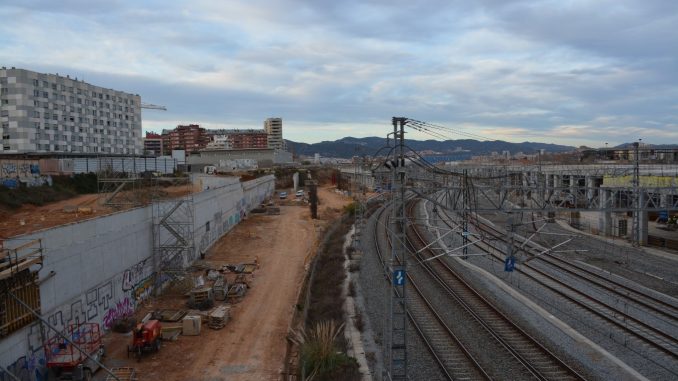
Photo: Construction works of La Sagrera, January 2021. Source: Ivan Ramirez Osorio.
Iván Ramírez Osorio
Universitat de Barcelona
The infrastructural processes, often ignored and associated with developmental discourses, are often evident in their failure, in their failures to reach their promises, in meeting the expectations that, in their embryonic facets, they profess, expose and delimit (Gupta, 2018). This logic applies both to small infrastructures, such as health care centres in poorly populated areas or neighbourhoods, urban and rural neighbourhood schools, as well as large infrastructures such as bus and train stations, airports, large production factories or huge motorways built for automotive mobility.
The infrastructural processes have their own temporality, transgress the times of government, the times of the market and establish themselves as a bridge between various temporalities. Thus, to talk about infrastructural time is to talk about a time that is associated with the planning, the ascent and the fall of the infrastructural processes (Appel, 2018). The infrastructure extends through tentacles and associations that surpass its physical materiality, which allow it to exercise, at the same time, as a system and systematised entity, which configures ways of inhabiting the cities and towns that are associated with this materiality (Larkin, 2013). So, I speak of infrastructure as an entity that is understood in association with political discourses, poetic ideals and forms of co-construction of the city that are constantly transformed and moved. When ideals and discourses are transformed into unfulfilled promises and the infrastructure, generally ignored, becomes evident in its failure, in its inability to give material form to what is said, to the dreamed, to the lived and the imagined.
The case of La Estación de Trenes de Alta Velocidad in the neighborhood of La Sagrera, in the city of Barcelona, is a clear example of the failure of the infrastructure, of the infrastructural time and of the promises that have been transformed and mutated over the more than 30 years of gestation of the construction project of La Estación. In the first place, there is talk of failure because La Estación does not finish arriving, because the problems it promised to solve have been overcome by the neighborhood and the people who inhabit it, in different ways, through another series of associative processes. There is talk of failure because of the chaotic interconnection between the city’s governing entities, the autonomous government and their broken relationship with the Spanish State, the absence of clear answers and the fading in the air of all the discourses of progress, growth and well-being that solidly developed during the rise of the Olympic spirit in the city of Barcelona. There is talk of an infrastructural time, in the second place, because in the failures of La Sagrera Station it has become evident the ephemeral of the political projects that constantly dispute to appropriate the success and merit of the construction of the great station. It has become evident that the time of construction of the infrastructure and its maintenance is of a relational nature (related to a wide multiplicity of entities) to see how the discourses regarding the project have been modified after the economic crisis and the housing crisis that occurred in Catalonia in the first decades of the st century. Finally, thirdly, we talk about the promises of infrastructure because these are constantly generated and destroyed in relation to the construction process that never ends and transforms illusions into frustrations, which transforms the desires to co-habit with La Estación into a constant process of claim and resignation, a constant rediscovery of failure and the eternal gestation of new dreams and small illusions. In many situations, those who wait for the completion of the construction, think that, like Vladimir and Estragon characters from Samuel Beckett’s renowned work, Waiting for Godot, they find themselves in a process of waiting that makes no sense since their conception, that does not present a hopeful panorama and that, in pain of these people, it seems, every day that passes, it corrodes the ability to live and exist in the neighborhood and to give a sense to the world around them and to the things that they want and expect. Thus, like Vladimir and Estragon, people who co-inhabit the process of building the station a false disjunctive: Wait or die.
Iván Ramírez Osorio
*Written product of an ethnographic research carried out in the neighborhood of La Sagrera to opt for a master’s degree in anthropology and ethnography at the Universitat de Barcelona.
Bibliography
Appel, H. (2018). Infrastructural Time. In N. Anand, H. Appel, & A. Gupta (Edits.), The promise of Infrastructure (págs. 41-61). Duke: Duke University Press.
Gupta, A. (2018). The Future in Ruins: Thoughts on the Temporality of Infrastructure. In N. Anand, H. Appel, & A. Gupta (Edits.), The Promise of Infrastructure (págs. 62-79). Duke: Duke Press University.
Larkin, B. (2013). The Politics and Poetics of Infrastructure. The Annual Review of Anthropology, 326-343.